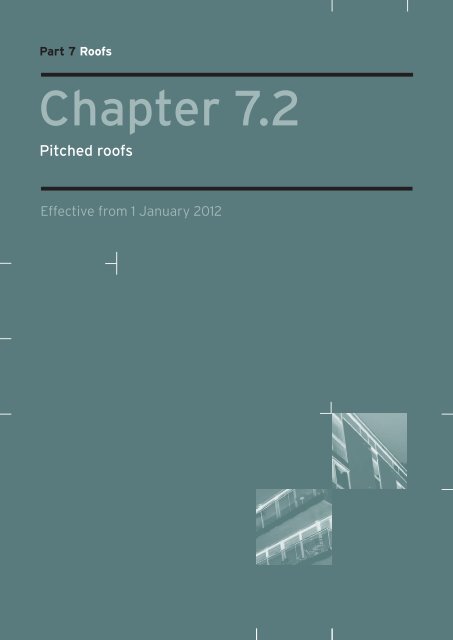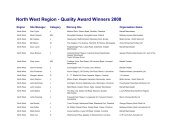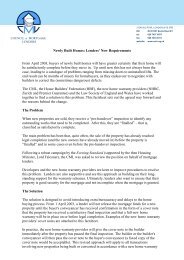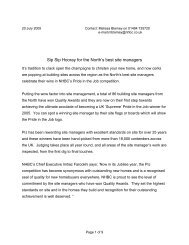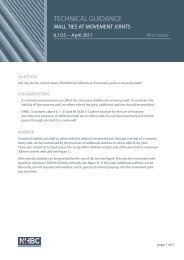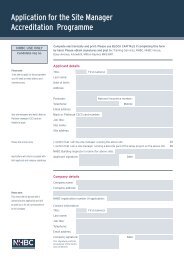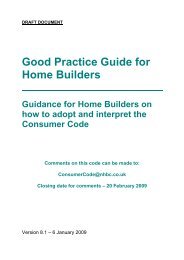NHBC Standards revised Chapter 7.2 'Pitched roofs'
NHBC Standards revised Chapter 7.2 'Pitched roofs'
NHBC Standards revised Chapter 7.2 'Pitched roofs'
- No tags were found...
You also want an ePaper? Increase the reach of your titles
YUMPU automatically turns print PDFs into web optimized ePapers that Google loves.
<strong>7.2</strong>Pitched roofsCONTENTSSCOPEDESIGN Clause PageDesign standards D1 1Statutory requirements D2 1Loadbearing structure D3-D4 1Trussed rafter roofs D5 1Traditional cut roofs D6 2Timber treatment D7 3Weathertightness D8-D9 3 - 4Insulation and control of condensation D10-D11 4Fire spread D12-D13 5Access D14 5Roof drainage D15 6Provision of information D16-D17 6This <strong>Chapter</strong> gives guidance on meeting the TechnicalRequirements and recommendations for pitched roofs,including trussed rafter and traditional cut roofs, verticaltiling, weatherproofing and insulation.MATERIALSMaterials standards M1 5Structural timber M2-M3 6Restraint straps and holding down straps M4 6Roofing materials M5 6Reclaimed materials M6 7<strong>7.2</strong>SITEWORKSitework standards S1 7Wall plates S2 7Strapping S3 8Trussed rafters S4-S6 8Traditional cut roofs S7-S8 9Water tank supports S9 10Fascias, bargeboards and soffits S10 10Roofing materials S11 10Flashings and weatherings S12 12Fire-stopping S13 14Thermal insulation S14 14Roof drainage S15 14APPENDIX <strong>7.2</strong>-ARoof tile fixings 15APPENDIX <strong>7.2</strong>-BBracing requirements for trussed rafter roofs 16APPENDIX <strong>7.2</strong>-CTank support details 18APPENDIX <strong>7.2</strong>-DSizes and spacing of tile battens 19APPENDIX <strong>7.2</strong>-EStrutting for attic trusses and cut roofs19that have a floorAPPENDIX <strong>7.2</strong>-FDurability classification of natural slates 19INDEX 20Page 2 <strong>Chapter</strong> <strong>7.2</strong>2011
Pitched roofs<strong>7.2</strong>DESIGN STANDARDS<strong>7.2</strong> - D1 Design shall meet the TechnicalRequirementsDesign that follows the guidance below willbe acceptable for pitched roofs.STATUTORYREQUIREMENTS<strong>7.2</strong> - D2 Design shall comply with allrelevant statutory requirementsDesigns should be in accordance withrelevant Building Regulations and otherstatutory requirements.LOADBEARINGSTRUCTURE<strong>7.2</strong> - D3 All pitched roof structures shallbe designed to support applied loads andself weight without undue movementItems to be taken into account include:(a) dead and imposed loadsDead and imposed loads should becalculated in accordance with BS EN1991-1-1, BS EN 1991-1-3 and BS EN 1991-1-4.Dead loads include the self weight of theroof structure and the roof covering.Imposed loads include snow loadings andthe weight of water tanks, insulation, etc.Structural timber should be specifiedaccording to the strength classes in BS EN338. Timber specifications when using BS4978 grading rules (eg GS) should be inaccordance with BS EN 1912 or strengthclass specified and also include thetimber species.(b) wind loadsWind loads appropriate to the site locationshould be calculated in accordance with BSEN 1991-1-4. The roof should be designed toresist wind uplift. This resistance is oftenprovided by the weight of the roof itselfbut holding down straps should beprovided where the self weight of the roofis insufficient.(c) holding down strapsHolding down straps may be required incertain geographical locations and withcertain types of roof construction. Someroof covering manufacturers providedetailed guidance.Where holding down straps are necessary,they should have a minimum cross sectionof 30mm x 2.5mm and be fixed atmaximum 2m centres. Steel straps with agalvanized finish are normally acceptable.The design should detail how straps are tobe fixed and what materials are to be used.The durability of fixings should becompatible with the straps.(d) sizing and spacing of membersSizing and spacing of rafters and ceilingjoists should be as:• Clause D5 for trussed rafter roofs• Clause D6 for traditional cut roofs.Generally, the spacing of rafters and ceilingjoists should be not more than 600mm.The spacing of ceiling joists should suit thethickness and size of the plasterboardsheets or other ceiling finish. Plasterboardsheets may be fixed at the following joistcentres:• 9.5mm sheets• 12.5mm and15mm sheets- up to 450mmspacing- up to 600mmspacingProprietary roof systems should bedesigned by an Engineer in accordancewith Technical Requirement R5.(e) size and spacing of tile battensThe size and spacing of tile battens shouldbe in accordance with the roof coveringmanufacturer’s recommendations, but notless than shown in the table inAppendix <strong>7.2</strong>-D.Nails for fixing battens should be 3.35mm(10 gauge) x 65mm long. Galvanizedsmooth round nails are acceptable, exceptwhere the maximum basic wind speed isover 26m/s (from National Annex FigureNA.1 of BS EN 1991-1-4), where ring shanknails should be specified.<strong>7.2</strong> - D4 All pitched roof structures shallbe designed so as to transmit loads andgive restraint to the supportingstructure without undue movementItems to be taken into account include:(a) wall platesNormally, trussed rafter roofs andtraditional cut roofs should be supportedon timber wall plates.Wall plates should be as detailed in ClauseD6(b) with regard to the table concerningminimum sizes. Fixings to connect the roofstructure to the wall plate should bespecified having regard to the roofconstruction and the exposure conditionsof the site.For trussed rafter roofs not subject touplift, the minimum fixing should be two4.5mm x 100mm long galvanized roundwire nails, skew nailed, one from each sideof the trussed rafter. Alternatively, trussclips can be used, fixed in accordance withmanufacturers’ instructions.In Scotland, nails should be appropriate towall plate dimensions.(b) holding down strapsIn situations where the roof is required toresist uplift, skew nailing is unlikely toprovide sufficient strength. Appropriatemetal straps should be used.(c) lateral restraint strapsFor dwellings of masonry construction,restraint should be provided at rafter levelfor gable walls. Larger gable or separatingwalls may also require restraint at ceilinglevel. See Sitework clause S3.Guidance in assessing when ceilingrestraint is needed can be found inBuilding Regulations.Lateral restraint straps should have aminimum cross section of 30mm x 5mmand a minimum anchorage downturn of100mm. The level of galvanizing for strapsand their fixings should be in accordancewith Tables A.1 and A.2 of BS EN 845-1.(reference should be made to Appendix6.1-F). Sheradizing is not acceptable inNorthern Ireland and the Isle of Man.Straps should be of sufficient length to befixed to three trusses and should be fixedwith solid blocking.In framed roofs, as an alternative, purlinsand pole plates can also provide restraint ifthe timber abuts a gable construction.Where purlins are used to provide restraintthey should not be spaced at more than2m centres, unless the design shows theyare adequate at greater spacing.In trussed rafter roofs, an alternative is toprovide restraint through gableladder detailing.(d) timber frame constructionFor dwellings of timber frame construction,the designer should ensure stability inaccordance with BS EN 1995-1-1.TRUSSED RAFTER ROOFS<strong>7.2</strong> - D5 Trussed rafters shall bedesigned to support applied loads andself weight without undue movementItems to be taken into account include:(a) recognised design standardsTrussed rafters should be designed inaccordance with BS 5268-3 (or PD 6693-2when published). Truss manufacturers mayhave their own computer programs forcalculating truss designs in accordancewith the British Standard.(b) design informationTo ensure that trussed rafters are correctlydesigned and fabricated, and are suitablefor their intended purpose, an accuratespecification is necessary.BS 5268-3 (or PD 6693-2 when published)gives a list of information to be supplied tothe truss manufacturer, including the:• height and location of building withreference to unusual wind conditions• profile of the trussed rafter, includingcamber, if required• span of the trussed rafter• pitch or pitches of the roof<strong>7.2</strong>2011<strong>Chapter</strong> <strong>7.2</strong>Page 1
Pitched roofs<strong>7.2</strong>Details of all structural members shouldbe provided.(d) strutting to cut roofsAny part of a cut roof which forms a floorshould have strutting in accordance withAppendix <strong>7.2</strong>-E.TIMBER TREATMENT<strong>7.2</strong> - D7 Measures shall be taken toensure durability of timberItems to be taken into account include:(a) treatment against HouseLonghorn BeetleIn some areas of the UK, treatment againstHouse Longhorn Beetle is required.Reference should be made to relevantBuilding Regulations. Reference shouldalso be made to <strong>Chapter</strong> 2.3 ‘Timberpreservation (natural solid timber)’ (Design).(b) timber requiring treatmentThe following timber members should beeither naturally durable or suitably treated:• fascias• bargeboards• soffits• tiling battens• other trim.These timber members should, whereappropriate, also be painted or stained inaccordance with the recommendations in<strong>Chapter</strong> 8.5 ‘Painting and decorating’(each section).In pitched roofs with a fully supportedweatherproofing membrane, the followingtimber members should be either naturallydurable or suitably treated:• rafters• purlins• ceiling joists• bracing• sarking• wall plates• battens for fixing vertical cladding.The level of durability of all the abovemembers can be achieved by naturaldurability or treatment with preservative.Reference should be made to <strong>Chapter</strong> 2.3‘Timber preservation (natural solid timber)’(each section) for guidance.of Appendix <strong>7.2</strong>-A, unless the manufacturerspecifies otherwise.Fixings for single and double lap tilesshould be designed in accordance with BS5534 and BS EN 1991-1-4. Where tilemanufacturers have computer programsbased on these British <strong>Standards</strong>, theirrecommendations should be followed.Tables 2 and 3 of Appendix <strong>7.2</strong>-A containminimum fixings for tiles. The tilemanufacturer will be able to advise on anyadditional nails or clips required for aparticular location. A fixing scheduleproduced by the tile manufacturer, basedon The Zonal Method, is acceptable.To avoid the use of small sections of cuttiles, which are difficult to fix, double tiles,tile-and-a-half or half tiles should be usedwhere available from the manufacturer.(c) slatesNatural slates should be fixed inaccordance with BS 5534 and BS EN1991-1-4. Each slate should be nailed twicewhen centre nailed.(d) roof coverings other than tilesor slatesLead sheet roofing should be inaccordance with BS 6915.Other types of sheet roofing should be inaccordance with the relevant parts ofCP 143.Roofs with the following traditionalcoverings should be designed inaccordance with satisfactory custom andpractice:• natural stone• shingles• thatch.Thatching should be as recommended bythe Thatch Advisory Service or otherappropriate authority in accordance withTechnical Requirement R3.Proprietary roof coverings including rooflights should be assessed in accordancewith Technical Requirement R3.(e) roof underlaysAn underlay should be provided for alltiled roofs.The underlay may be felt to BS EN 13707 ora proprietary sarking membrane complyingwith Technical Requirement R3. Wherethe underlay is exposed at eaves level itshould be UV resistant or type 5U felt.Alternatively, proprietary eaves guardsmay be used. A type 1F felt may be usedfor the remainder of the roof.To prevent the underlay sagging at theeaves and forming a water trap behind thefascia, the underlay should be supportedby a continuous fillet or proprietary eavessupport tray.(f) rigid sarkingIn areas of severe exposure, a rigid sarkingwith underlay is recommended and isnormal practice in Scotland.The choice of rigid sarking should takeaccount of the type and fixing of the roofcovering. The following materialsare acceptable:• tongued and grooved or square edgedboarding to BS 1297• bitumen impregnated insulating boardto BS 1142 : Part 3 (sarking andsheathing grade)• exterior grade plywood to BS EN 636service class 3• type P5 chipboard to BS EN 312• oriented strand board type OSB3 toBS EN 300• proprietary products which have beenassessed in accordance with TechnicalRequirement R3.To avoid damage from condensation,proprietary insulation boards should beused strictly in accordance with therecommendations given in theindependent assessment.(g) flashings and other weatheringdetails where a pitched roof abuts avertical surfaceWhere a roof abuts a vertical surface,cover flashings, stepped cover flashings,soakers, secret gutters and back orparapet gutters should be provided asnecessary. Where the roof is over anenclosed area the wall construction shouldinclude cavity trays linked to the flashings.Reference should be made to Siteworkclause <strong>7.2</strong> - S12(f) for details.Cover flashings should be tucked 25mminto a brick joint or chase not less than75mm above the intersection with the roof.Flashings and soakers should be ofnon-ferrous metal and of the samematerial to avoid electrolytic action.Where lead is used, soakers should be atleast Code 3 and flashings, gutters,saddles, etc should be Code 4 or better.In the case of gutters behind parapet walls,provision should be made for an overflowin case the outlet becomes blocked.<strong>7.2</strong>WEATHERTIGHTNESS<strong>7.2</strong> - D8 Roofs shall be designed tosatisfactorily resist the passage of rainand snow to the inside of the buildingItems to be taken into account include:(a) weathertightness of roof coveringsRoofs with a tile or slate covering shouldbe designed in accordance with BS 5534 :Parts 1 and 2.(b) tilesFor tiled roofs, the pitch, gauge and lapshould be within the limits given in Table 1(h) weathering details where a pitchedroof intersects with a continuouswaterproof membraneFor information on intersections with flatroofs, gutters or valleys, reference shouldbe made to Sitework clause <strong>7.2</strong> - S12(e).(i) pipesWhere soil pipes, vent pipes or other pipespenetrate roof tiling, a lead slate flashing,or a purpose-made accessory to form aweathertight joint, should be used.If lead slates are used, they should besupported (eg using exterior gradeplywood) to prevent the lead sagging.2011<strong>Chapter</strong> <strong>7.2</strong>Page 3
<strong>7.2</strong>Pitched roofsSTRAPPING<strong>7.2</strong> - S3 Straps shall be used, wherenecessary, to restrain gable andseparating walls and hold down the roofagainst wind upliftRESTRAINT STRAPSRestraint straps, or a restraining formof gable ladder, are required to providestability to walls. They should be installedas shown in the design and at not morethan 2m centres for buildings up to threestoreys (two storeys in Scotland). Higherbuildings straps should be spaced at notmore than 1.25m centres.Restraint straps should be fixed to solidnoggings with a minimum of four fixings ofwhich one should be in the third rafter. Thefixings should be four steel screws or four75mm x 4mm (8 SWG) round nails.Rafters should not be notched to make thestraps flush with the rafter. Straps shouldgo under rafters and over ceiling joists.The turn-down should be on a substantialpiece of blockwork, preferably the centreof an uncut block.strap with cross section of30mm x 2.5mmstrap at least 1m longat least4 fixingsper straplowest fixing notmore than150mm frombottom of strapSceiling tierafterprojection not more than:-50mm, or-one-third x S whichever is the greater<strong>7.2</strong>packing betweenrafter and wallstrap heldtightly againstblock inner leafnogging fixedhorizontallyavoids twistingrestraint strapsstrap fixed to solidnoggings with at leastfour fixings of whichat least one to be inthe third rafterHOLDING DOWN STRAPSIf the design specifies holding down strapsto prevent the roof being lifted off thesupporting structure, they should be at 2mcentres (maximum).Where straps are fixed to masonry,hardened nails 4mm in diameter x 75mmlong or No 12 wood screws x 50mm longinto plugs should be used.The number of fixings should be inaccordance with design requirements andthe lowest fixing should be within 150mmof the bottom of the vertical strap.TRUSSED RAFTERS<strong>7.2</strong> - S4 Trussed rafters shall beprotected from damage before andduring constructionItems to be taken into account include:(a) storageTo avoid distortion and prevent damage,trussed rafters should be stored clear ofthe ground, either flat on level bearersplaced under joints (for short termstorage) or vertically and propped (for longterm storage).Trusses should be protected againstweather to prevent corrosion of trussplates and deterioration of the timber.Ventilation should be provided.Any damaged trussed rafters or trussedrafters with loose plates should berejected, not repaired.(b) handlingTo prevent distortion during construction,trussed rafters should be carried upright(if carried flat, bending can loosenthe fasteners).<strong>7.2</strong> - S5 Trussed rafters shall beerected in accordance with fabricators’instructionsDetailed guidance on the use and handlingof trussed rafters is given in theInternational Trussed Rafter AssociationTechnical Handbook available from trussedrafter suppliers.Detailed drawings should be available onsite to show the layout of the trussedrafters, especially at hips, valleys andtrimmings to chimneys, etc.Trussed rafters should be supported onlyat the junction between the ceiling tie andrafter, unless specifically designedotherwise, eg as a cantilever.Trussed rafters should be evenly spacedand vertical. Temporary bracing should beprovided to control the spacing and keeptrusses vertical.Trussed rafters should be fixed to the wallplates either:• in accordance with the design, or• using double skew nailing or truss clips.Avoid damaging the metal truss plates,trussed rafters or wall plates.The spacing or structure of trusses shouldnot be altered without thedesigner’s approval.Where the width of gable ladders exceedsthat of the trussed rafter centres, noggingsshould be provided to reduce the span ofthe roofing tile battens.last trussedrafter closeto wallnot more than 600mm centresbargeboardnoggings toreduce spanof tile battensThe gable ladder can be used to providerestraint to the external wall if:• there is blocking between the lasttrussed rafter and the inner leaf (at amaximum of 2m spacing), and• the soffit board is cut carefully and thenfixed securely so as to restrain theouter leaf.<strong>7.2</strong> - S6 Trussed rafters shall be bracedto prevent distortionThe roof should be braced using at least100mm x 25mm timber. All bracing shouldbe twice nailed with 3.35mm (10 gauge) x65mm long galvanized round wire nails toevery trussed rafter it crosses and tothe wallplate.Page 8 <strong>Chapter</strong> <strong>7.2</strong>2011
Pitched roofs<strong>7.2</strong>The minimum bracing requirements areshown in Appendix <strong>7.2</strong>-B. Additionalbracing may be needed in exposed areas.Check the design drawings forspecial requirements.All bracing should be completed beforestarting to lay the roof covering.Longitudinal binders should butt solidlyagainst the wall at each end. This is mosteasily achieved by fixing the binder in twolap-jointed lengths.Braces and binders, where not continuous,should have lapped joints and be nailed toat least two trusses.binders abutedtightly against gableand separating wallsbinders fixed to ceiling ties of trussed rafters,if necessary using two lap-jointed lengths• CEILING BINDERS and HANGERS:support long span ceiling joists• POLE PLATES: similar to purlins butused where ceiling joists are above wallplate level.Positions of standard structural membersare shown in the diagrammaticrepresentation below:pole platespanning betweenloadbearing wallshangerwall plateridgepurlinbindercollarstrut(d) dormer constructionOn most dormers, the dormer cheek studsshould be supported either by a doublerafter or by a double floor joist.dormercheek studsplatedouble joistcarrying dormercheek studsdormer rafter ifcarrying dormercheek studsWhere cheek framing does not extend tofloor level, a double rafter will givenecessary support to the cheek. The tworafters must be fixed together.Trimming members around dormers shouldbe large enough to take the extra loadfrom the cut main roof members anddormer framing and cladding, as detailedin the design.Dormers should be framed up so they areindependent of the window frame, using asuitable lintel over the opening.The part of an attic truss which forms afloor should have strutting in accordancewith Appendix <strong>7.2</strong>-E.TRADITIONAL CUT ROOFS<strong>7.2</strong> - S7 Roof timbers shall be of thegrades and sizes shown on the drawingsStructural timber should be marked toshow its strength class (normally C16 orC24). Alternatively, evidence of speciesand grade should be available to determinethe equivalent strength class.The correct size of timber should be usedfor each member, as shown on thedesign drawings.<strong>7.2</strong> - S8 Construction of traditional cutroofs shall ensure adequatestructural stabilityItems to be taken into account include:(a) location of membersAll members should be accurately located.Purlins and binders should be built in,where necessary. In a typical traditionalroof, the basic timber members are:• RAFTER: carries the weight of the rooffinish, eg tiles, tile battens and underfelt• CEILING JOIST or TIE: triangulates therafters, stopping the walls and roofspreading outwards; supports the ceilingfinish and any walkways, etc• RIDGE: provides fixing and spacing forthe tops of rafters• PURLIN: supports long span rafters toprevent deflection and increase stiffness• STRUTS: give support to purlins toprevent deflection and transmit roofloading to loadbearing structure below.• The following are extra members whichmay be used on large roofs:• COLLAR: ties the roof together atpurlin levelloadbearing wall(b) prevention of distortion andoverloadingThe design details for sizes of timbermembers should be followed.All framing should be completed beforeroof coverings are laid.If a roof is not a simple triangle, allmembers should be fully supported andtied together. If necessary, temporarysupport to long span members should beused until the framing is complete.(c) valley and hip constructionParticular care is needed in theconstruction of valleys and hips:• Valley rafters carry load from bothsections of the roof. Valley rafters willneed to be larger than ordinary raftersto take the extra load and to providefull bearing for the splay cut of Jackrafters. (Long valley rafters may needintermediate support.)• Hip rafters provide spacing and fixingfor jack rafters. They need to be adeeper section than other rafters totake the top cut of the jack rafters.Purlins should be mitred at hips, and lipcut to accept the bottom of thehip rafter.hip raftersjack raftersvalley rafterjack rafterslintel supportsdormer rooftrimmer takes loadfrom cut rafterstrimmer takes loadfrom cut rafterslay boarddouble rafter supportsdormer cheek studs andload from the trimmer(e) jointing of membersAll joints should be cut accurately to fittightly. When they are nailed, care shouldbe taken not to split members.The following should be used atmain connections:• RAFTERS to ceiling joists: nailed lappedjoint. The rafter should be birdsmouthedover and skew nailed to the wall platerafters skewnailed towall plate<strong>7.2</strong>2011<strong>Chapter</strong> <strong>7.2</strong>Page 9
<strong>7.2</strong>Pitched roofs• RAFTERS to purlin: a birdsmouth jointshould be used if the purlin isfixed verticallybirdsmouth joint¹⁄ x d ³dAngle ties should be used on hippedroof corners to prevent the wall platesspreading. For heavily loaded hip rafters,eg where they are carrying purlins, dragonties or similar bracing should be used toprevent hip rafter spread.timber angle tieprevents wallplates spreadingFASCIAS, BARGE BOARDSAND SOFFITS<strong>7.2</strong> - S10 Fascias, bargeboards andsoffits shall be selected, fixed andtreated against decay in accordancewith the designItems to be taken into account include:(a) timber qualityTimber for external feature work should befree from waney edges, large knots andresinous pockets, splits and otherunsightly defects.• PURLIN connections: support should beprovided directly under joint or use ascarf joint. Any scarf joint should bemade near a strut so that the jointsupports the longer span.halving joint in purlinwhen directly over strutdragon tieprevents spreadof hip raftersteel tie preventsspread of hip rafterplywood angle tieprevents wallplates spreading(b) fixingAll joints should be cut and fixed neatly.Mitred angles and splay joints shouldbe used to prevent exposure of endgrain.Butt joints to fascias should besplayed. Fascia boards should have twofixings into each rafter and be fixed at aheight that maintains the correct pitch inaccordance with the tile manufacturer’srecommendations.(c) treatment against decayWhere preservative treated timber is cutor planed, a liberal brush coating ofpreservative should be applied.All untreated timber that is to be paintedshould be knotted and primed all roundbefore fixing. When timber requires astained finish, one coat of stain should beapplied before fixing.notch to fitover angle tieangle tieROOFING MATERIALSscarf joint near strutsupporting longerspan of purlin<strong>7.2</strong> - S11 Roofing materials shall beinstalled in accordance with the designItems to be taken into account include:<strong>7.2</strong>wedges and metalplate to tighten joint(f) strutting to cut roofsAny part of a cut roof which forms a floorshould have strutting in accordance withAppendix <strong>7.2</strong>-E.WATER TANK SUPPORTS<strong>7.2</strong> - S9 Loads from water cisterns shallbe transferred to:(a) the node points of trussed raftersIn trussed rafter roofs, tank stands shouldbe supported at the node points of thetrussed rafters and the load spread over atleast three trusses.Correct supports are illustrated inAppendix <strong>7.2</strong>-C.(a) ventilationAll roof voids should be ventilated toprevent condensation problems.Ventilation openings where the leastdimension exceeds 10mm should beprotected with mesh to prevent entry ofbirds, etc.Where proprietary eaves ventilators areused, they should be fixed in accordancewith the manufacturer’s instructions.For roofs that incorporate a high watervapour resistance (type HR) underlayventilation should be provided on oppositesides of the roof space, equivalent to acontinuous gap of the width shown in thefollowing drawings:(b) suitable bearers in traditionalcut roofsIn traditional cut roofs, tank stands shouldbe supported as shown in the design.5mm5mm where pitchoexceeds 35 orspan exceeds 10m10mm10mmROOF PITCH OVER 15 oPage 10 <strong>Chapter</strong> <strong>7.2</strong>2011
Pitched roofs<strong>7.2</strong>25mmROOF PITCH BELOW 15 o10mm or 25mmto suit pitch5mm25mmFor unventilated cold roofs thatincorporate a low water vapour resistance(type LR) underlay, (eg a vapour permeableunderlay) and insulation over a horizontalceiling ridge or high level ventilationequivalent to a continuous opening of5mm should be provided in accordancewith the design.5mm continuoushigh level ventilationwith LR underlayThe main roof underlay should be cut tothe valley batten line.The underlay should be supported andturned up at least 100mm at all abutmentsto prevent rain and snow being blown intothe roof space.Particular care is needed where pipesproject through the underlay. Tornunderlay around pipes can lead to theceiling becoming wet and stained. To avoidwater penetration the underlay should becut neatly to fit tightly aroundservice penetrations.MONO-PITCHED ROOFat least 50mmclear airway25mm25mm5mm5mmROOM-IN-ROOF (flat roof dormer)25mm50mm5mm5mmROOM-IN-ROOF (partially sloping ceiling)25mm50mm5mm5mmat least 50mmclear airway5mm25mm(b) underlaysHorizontal laps should be as follows:PitchMinimum horizontal lap(underlay not fullysupported)Less than 15° 225mm15° to 34° 150mm35° and above 100mmVertical laps in the underlay should occuronly over rafters and be securely fixed.Horizontal laps should be securely fixed byregular roofing battens.Underlay should be supported at eaveslevel by a tilting fillet or proprietaryeaves support tray. Where the underlayis exposed at eaves level it should be UVresistant or type 5U felt. Alternatively,proprietary eaves guards can be used. Atype 1F felt may be used for the remainderof the roof.Underlay or eaves guards should bedressed into the gutter.(c) battens and counter battensBattens should be set out in straight lines,parallel to the ridge and to the gaugerequired by the tile or slate. The lap shouldnot be decreased because this would reduceweathertightness. The lowest batten shouldbe fixed so that the tile projects not lessthan 50mm over the gutter.Battens should be:• at least 1.2m long• supported by at least three rafters• butt jointed on a rafter, and• nailed to every rafter.Batten ends should be cut square andnails skew driven on each side of the joint.Where battens are spaced at more than200mm, not more than one batten in anygroup of four should be joined over anyone truss or rafter. Not more than threejoints should be made together in twelveconsecutive battens when the gauge is200mm or less.Battens on rigid sarking boards should besupported on counter battens to allow freedrainage of any water that may reach theunderlay. Counter battens should be fixedthrough to the rafters and not to thesarking boards alone. Battens should befixed through counter battens to rafters.Battens should be fixed with cut or wirenails. The nail shank can be smooth,annular ringed or helically threaded. Nailscan be steel or aluminium. In coastal areas,steel nails should be hot dip galvanized.<strong>7.2</strong>ROOM-IN-ROOF (completely sloping ceiling)10mm or 25mmto suit pitchPITCHED ROOF DORMER10mm or 25mmlap to suitpitch of roofunderlay supportedby tilting fillet anddressed into gutterWhere traditional mortar pointing is usedto bed ridge tiles, the underlay shouldextend over the ridge. Underlay shouldcontinue over hips to form a 150mmminimum lap parallel with the hip rafter.At valleys, a strip of underlay should belaid under the main roof underlay and helddown by the valley battens, where used.(d) slates and tilesSlates should be fully nailed over thewhole roof.The design should specify the number offixings for clay and concrete tiles. Tables 2and 3 of Appendix <strong>7.2</strong>-A contain minimumfixings for tiles. Additional nails and clipsmay be necessary in accordance with thedesign. A fixing schedule produced by thetile manufacturer, based on BS 5534 orThe Zonal Method, is acceptable.Careful setting out will improve thefinished appearance of the roof andhelps to avoid problems such as unequaloverhangs at verges and often makes itpossible to avoid excessive tile cutting at2011<strong>Chapter</strong> <strong>7.2</strong>Page 11
<strong>7.2</strong>Pitched roofsabutments, chimneys and similarobstructions. Small sections of cut tiles aredifficult to fix and should be avoided. Thiscan be achieved by incorporating tile sizessuch as double size tiles, tile and a half orhalf tiles where these are available.Single lap Interlocking tiles have atolerance of approximately 3mm in thejoint. For double lapped plain tiles andslates, joints should be slightly open. Thisallows some flexibility in setting out andshould avoid tile cutting.Bottom edges of double lapped slate andplain tile roofs should be finished with anunder-eaves course.cut tilesavoidedat vergeThatching should be as recommended bythe Thatch Advisory Service or otherappropriate authority in accordance withTechnical Requirement R3.FLASHINGS ANDWEATHERINGS<strong>7.2</strong> - S12 Flashings and weatheringsshall be constructed to prevent dampentering the dwellingItems to be taken into account include:(a) eavesTiles, slates and hip tiles should overhangto the centre of the gutter. For slates orplain tiles, an under-eaves course shouldbe used. Fascia boards should be fixed ata height that maintains the correct pitchin accordance with the tile manufacturer’srecommendations.Tile battens should finish 25mm to 50mmfrom the face of the protecting undercloak.Cut ends of tile battens that are in contactwith mortar should be treated with aliberal brush coating of preservative.At verges:• cut plain tiles are not acceptable andpurpose made plain tile and a half orhalf tile should be used• cut single lapped interlocking tilesshould not be used• natural slate verges should be formedwith full slates and either slate and ahalf or half slates that are a minimum150mm wide.verge tilesbedded inmortar onundercloak100mmtile-and-a-halftiles used forcorrect coursingcoverings to projectnot less than 50mmacross gutter38mm to 50mmor30mm to 60mmunderlay takenover wall cavity<strong>7.2</strong>Where verge clips are specified by themanufacturer, these should be twice nailedto the tile batten and be in full contact withthe upper tile surface to prevent tile lift.Tiles to be bedded on mortar should bewetted first on their contact surface.Surface water should be allowed to drainbefore fixing. Substantial thicknessesof mortar bedding may be needed, egbeneath rolled tiles. To prevent shrinkageof large mortar joints, concealed ordecorative dentil tiles should be fullybedded into all joints in excess of25mm thick.Proprietary dry fixed systems should beassessed in accordance with TechnicalRequirement R3.(e) roof mortarRoofing mortar should be 1:3 cement:sandwith plasticiser. The mix should be basedon sharp sand with soft sand added toachieve workability. The proportion ofsharp sand should not be less than ⅓ ofthe total sand content.Alternatively, proprietary mortar mixesmay be accepted by <strong>NHBC</strong> if they areshown to have similar strength, durabilityand workability.Mortar bedding and jointing should becompleted in one operation.(f) other roof coveringsWhen using the following materials, thedetailing and workmanship should follow thedesign and recognised good building practice:• sheet metal roofing including lead,copper and zinc• thatch• cedar shingles.underlay dressedinto gutter belowunder-eaves tilesTo prevent the underlay sagging at theeaves and forming a water trap behind thefascia, the underlay should be supportedby a continuous fillet or proprietary eavessupport tray.(b) vergesAll verge tiles and slates should be beddedon an undercloak. Alternatively,proprietary dry verge systems should befixed in accordance with manufacturers’recommendations.The undercloak should be installed to atrue line and bedded on roofing mortarstruck off flush with the external surfaceof the wall. Alternatively, a suitableexterior grade bedding sealant could beused in accordance with manufacturer’srecommendations. Where a bargeboard isused, the undercloak should be securelynailed to a true line.The undercloak should be installed at thecorrect level to ensure that the line of thetiling is maintained where it passes overthe wall.Where slates or plain tiles are used theverge should project 38mm to 50mmbeyond the gable wall or bargeboard.Interlocking tiles can project 30mm to60mm.The undercloak should lap the roofunderlay but not tilt inwards. Wet beddedverge tiles or slates should be fully beddedon roofing mortar having a minimum widthof 100mm. Verge slates or tiles should bebedded on the undercloak and completedin one operation.Where required by the design interlockingsingle lap tiles should be secured with clipsand twice nailed in position at the tile lap,as well as bedded in mortar. Verge clipsshould be in full contact with the tile toresist uplift.(c) ridges and hipsWhere ridge and hip tiles are beddedon mortar they should be mechanicallyfixed with self sealing non-ferrous fixingsinto timber battens. Where proprietarysystems are used they should be fixedin accordance with manufacturer’srecommendations.underlay carriedover ridgeridge tiles bedddedin mortar andmechanically fixedMortar bedding and pointing should becompleted in one operation and achievea nominal joint thickness of 10mm. Toprevent shrinkage of large mortar joints,concealed or decorative dentil tiles shouldbe fully bedded into all joints in excess of25mm thick. See Design clause D8(k).Page 12 <strong>Chapter</strong> <strong>7.2</strong>2011
Pitched roofs<strong>7.2</strong>Where wet bedded tiles are used at hips,they should be supported at the base ofthe hip by a galvanized hip iron and projectto the centre line of the gutter.(d) valleys and hidden guttersConstruction should be adequate inrelation to:• depth• width• undercloaking• pointing• adequate support• pitch.Valleys should be formed with one ofthe following:• pre-formed GRP• valley coursing tiles (plain tiles)• valley trough tiles (interlocking tiles)• non-ferrous metal• a proprietary system.Where roof coverings are of plain tiles orslates, laced and swept valleys may beused or, alternatively, a mitred valley withsoakers. The true pitch of the valley shouldnot be less than the minimum allowedpitch and GRP or other materials should belapped in accordance with manufacturer’srecommendations. Minimum Code 4lead or other suitable saddle flashing isrequired at the head of all valleys.PROPRIETARY SYSTEMSProprietary gutter or valley systems shouldbe securely fixed on to suitable supportsand in accordance with the manufacturer’srecommendations. Where ply is used forsupport it should be exterior grade.Non-ferrous metal saddle flashings orother approved proprietary flashingsshould be used at intersections andabutments. Lead flashings should be atleast Code 4 (colour coded blue).the manufacturer’s recommendations andsmall cut tiles should be avoided.For single lap interlocking tiles, purposemadevalley trough tiles should besupported by gutter boards. Roof tilesshould be cut to the correct rake.Mechanical cutting gives a neaterappearance than hand cutting. The tilesshould be bedded in mortar, leaving aminimum 100mm wide channel (125mmminimum for pitches below 30°).LEAD-LINED VALLEYLead-lined valleys should be Code 4 (colourcoded blue) or Code 5 (colour coded red)and supported on gutter boards of 19mmthick exterior grade ply or as specified.Lead in valleys should be laid in lengthsnot exceeding 1.5m and be lapped 150mmat each length. Tiles should be cut andbedded as for valley trough tiles exceptthat the mortar should be bedded on anundercloak (for example slate) to preventdirect contact between the lead and themortar. Mortar should not bridge thewelt detail.(e) flat roof intersectionWhere a flat roof adjoins a pitched roof, orwhere valleys or gutters occur, thewaterproof membrane should be carriedup under the tiling to a height of 150mmabove the flat roof, valley or gutter andlapped by the roofing underlay.The lowest course of tiles/slates should nottouch the roof membrane.fallapprox 150mmunderlay overlapsweatherproofingat least 150mmpointed in cement mortar or using suitableexterior grade sealant in accordance withthe manufacturer’s recommendations.Cavity trays should be linked to theflashing to prevent water penetrating intoan enclosed area where a:• flat or pitched roof over an enclosedarea abuts a wall• balcony abuts a wall.underlayturned upbehindflashinglead flashingwedged into jointbelow wall dpcat least 75mmat least 150mmclip free edge offlashing - methoddepends onexposureWhere a pitched roof abuts the wall at anangle, a stepped cavity tray linked to astepped flashing should be used. Steppedflashings should be cut from a strip atleast 150mm wide. Soakers or a secretgutter should be installed at abutmentswhere slates, flat interlocking tiles or plaintiles are used.soakers beneatheach tile overlappedflashingstepped lead flashingheld in mortar jointswith lead wedgesGRP valley gutteredge tiles cut to rakeand bedded in mortar<strong>7.2</strong>valley undercloak stripVALLEY USING VALLEY TILESIn roofs with plain tiles, purpose-madevalley coursing tiles should be used.Adjacent roof tiles should be cut neatly toform a smooth junction, preferably cuttingfrom tile-and-a-half tiles.A laced valley, swept valley or mitred tileswith soakers may also be used. All valleytiles should be fixed in accordance withNoteWhere the flat roof is over a dormer, it isrecommended that the flat roof should bedesigned and constructed with a fall to thefront or sides.Flat roofs should comply with <strong>Chapter</strong> 7.1‘Flat roofs and balconies’ (Sitework).(f) abutmentsAll abutments should be weatherproofedusing non-ferrous metal flashings. Leadflashings should be at least Code 4 (colourcoded blue), while soakers are normallyCode 3 (colour coded green). Normally,lead flashings should not exceed 1.5m inlength, with laps of not less than 100mm.Flashing should be tucked into a mortarjoint or chase 25mm deep and at least75mm above the tiling level and leadwedged in place. The joint should beunderlay turned upat abutment(g) projections through the roofA purpose-made one-piece flashing andupstand should be used around pipesprojecting through the tiling.plastic collarsolvent weldedto pipewelted edgeto flashingone piece flashingand sleeve around pipe2011<strong>Chapter</strong> <strong>7.2</strong>Page 13
<strong>7.2</strong>Pitched roofsChimney flashings should link with thechimney dpc trays. An example isshown below.coverflashingat least 150mmDETAIL OF BACK GUTTERback gutterflashing supportedby gutter boardscover flashingA cavity barrier should be provided withinboxed eaves. The cavity barrier should bewire reinforced mineral wool blanket, atleast 50mm thick, nailed to the rafter andcarefully cut to shape to fully seal theboxed eaves.firestop between battensabove underlayfirestop belowunderlayThe guidance above will assist in reducingthe risk of condensation occurring but isnot acceptable as an alternative to crossventilation of the roof space.To reduce the risk of freezing andcondensation on pipework, the followingprecautions should be taken:• place roof insulation above and aroundwater tanks but not below them• locate water pipes below the main roofinsulation whenever possible• insulate all water services above themain roof insulation, including cisternsand vent pipes.upper dpc traybackgutterflashingcavity barrier ofmineral wool orfire-resisting boardin boxed eavescavitybarrier inseparating wallcavity closedat eaveslap tankand loftinsulationpipes insulatedwhen aboveloft insulation<strong>7.2</strong>front apron flashingstepped sideflashinglower dpc tray(h) changes in roof slopeFlashings or soakers should be used wherethere is a change in roof slope of 5° ormore, eg at mansards and sprockets.A saddle flashing should be used where aridge meets the main roof.lead saddleflashingdressedover GRPvalley gutterGRP valley gutterFIRESTOPPING<strong>7.2</strong> - S13 Pitched roofs shall beconstructed to offer adequate resistanceto the spread of fireFirestopping and cavity barriers shouldbe provided:• at junctions between cavities• above separating walls• within boxed eaves of separating walls.The separating wall should stop about 25mmbelow the top of adjacent roof trusses.A soft fire-resistant packing, such asmineral wool, should be used to allow formovement in roof timbers and prevent‘hogging’ of the tiles.THERMAL INSULATION<strong>7.2</strong> - S14 Thermal insulation andventilation of roofs shall prevent theadverse effects of condensationTo avoid condensation forming in the roofspace ensure that:• ventilation of the roof is provided inaccordance with the design• insulation does not block anyventilation paths• insulation is laid over the whole loftarea, including the wall plate• there are no gaps in the insulation.ventilationspacer maintains25mm clear air wayabove insulationcold roofinsultation abovecavity closer andwall plate avoidsa cold bridgeThe amount of moist air entering theloft space from the dwelling should becontrolled by:• draughtstripping the loft hatch or usinga proprietary loft hatch• ensuring that the hatch is heavy enough(or suitably fixed) to compress thedraught seal• the use of appropriate down lightersthat limit air leakage• sealing gaps where services passthrough the ceiling.crossventilationloft hatchdraughtstrippedgaps sealedat servicesrising maininsulated aboveceiling levelIt is recommended that the cold risingmain be insulated above ceiling level evenif it is below the main roof insulation(condensation that forms on uninsulatedcold water pipes located below the mainroof insulation can result in damage toceilings and decorations).ROOF DRAINAGE<strong>7.2</strong> - S15 Roof drainage shall adequatelycarry rainwater to an outfallItems to be taken into account include:(a) fixing and jointing guttersand downpipesRainwater gutters and downpipes shouldbe fixed in the positions indicated by thedesign using the correct type of fittings forinternal and external angles, outlets, etc toensure efficient drainage of the roof.Gutters and downpipes should besupported and jointed in accordance withthe manufacturer’s recommendations.Rainwater pipes passing through dwellingsshould be insulated in accordance withSitework clause 8.1 - S8(c).(b) fallsGutters should be laid with sufficient falltowards the outlet, unless designed to beflat, and be provided with stop ends.(c) satisfactory outfallIf a downpipe discharges above groundlevel or above a drainage gully, a shoeshould be fixed to the end of the pipe toprevent walls becoming saturated.U1Page 14 <strong>Chapter</strong> <strong>7.2</strong>2011
Pitched roofs<strong>7.2</strong>Appendix <strong>7.2</strong>-ARoof tile fixingsTable 1 - Recommended limits of pitch, gauge and lap for roof tilesType of tile Gauge Minimum head-lap (mm) Minimum permissible pitch (°)Plain(double-lap)not more than ⅓ length-lap65 normally for clay tiles75 in severe exposure conditions35 1 (clay)35 (plain concrete)Concrete(single-lapinterlocking)determined by design to comply withmanufacturers’ recommendations75 or to manufacturer’s specificrecommendations30 (Note: For pitches below 30,evidence shall be provided as tosuitable performance)Slates(double-lap)not more than ⅓ length-lap54 2 minimum, increase with lowerpitch and severe exposureconditions20 subject to head lapNotes1 Clay tiles that do not meet the dimentional and geometric requirements given in BS EN 1304 should be laid at pitches not less than 40˚.2 For pitches greater than 45˚in sheltered and moderate exposure zones only. See BS 5534 table 5 for other pitches and exposures.Table 2 - Minimum fixings for single lap interlocking clay and concrete tilesLocationVerges, abutmentsand each side ofvalleys and hipsEaves and top edgesGeneral roof areaFixingsThe end tile in each course should be fixed (nail and/or clip)Each tile in the first course at the eaves and last course at the ridge/top edge should be fixed (nail and/or clip)For rafter pitches below 45° - tiles should be fixed in accordance with manufacturer’s recommendations.For rafter pitches between 45° and 55° - all tiles should be nailed or nailed and clipped.For rafters pitches of 55° and above - all tiles should be nailed and the tail of each tile should be mechanically fixed.Notes1 Additional nails or clips may be required depending on pitch and degree of exposure. Follow the manufacturer’s recommendations. Afixing schedule produced by the tile manufacturer, based on The Zonal Method, is acceptable. Evidence of calculations in compliance withTechnical Requirements R3 and R5 may be required.2 Nails should be in accordance with BS 5534 and be not less than 3.35mm diameter and should penetrate at least 15mm into battens.Table 3 - Minimum fixings for double lap clay and concrete plain tilesLocationVerges, abutmentsand each side ofvalleys and hipsEaves and top edgesGeneral roof areaFixingsThe end tile in each course should be twice nailedEach tile in the first two courses at the eaves and last two courses at the ridge should be twice nailed or otherwise mechanically fixed.Nibbed tilesFor rafter pitches below 60° - each tile in every fifth course should be twice nailed.For rafter pitches 60° and above - all tiles should be twice nailed.Nibless tilesAll tiles should be twice nailed.<strong>7.2</strong>Notes1 Additional nails or clips may be required depending on pitch and degree of exposure. Follow the manufacturer’s recommendations. Afixing schedule produced by the tile manufacturer, based on The Zonal Method, is acceptable. Evidence of calculations in compliance withTechnical Requirements R3 and R5 may be required2 Nails should be in accordance with BS 5534 and be not less than 2.65mm diameter and should penetrate at least 15mm into battens.2011<strong>Chapter</strong> <strong>7.2</strong>Page 15
<strong>7.2</strong>Pitched roofsAppendix <strong>7.2</strong>-BBRACING REQUIREMENT FOR TRUSSED RAFTER ROOFSType of bracing Position of bracing Where applicableADiagonal rafter bracing(at approx. 45° on plan)Truss SpanororAll trussed rafter roofs unless rigid sarkingsuch as OSB, timber boarding or plywood is used.Alternative styles of bracing for roofs that are approximately squareTruss SpanororAlternative styles of bracing for larger roofsTruss SpanXBracing for narrow fronted roofs(less than 6.6m wide) of detachedor staggered/stepped buildingsIntersection detail ‘X’22 x 97 x 600mm longtimber splice plate nailedusing minimum of 4 No.3.35mm x 65mm longgalvanised round wire nailseach side of intersectiondriven through bracing andclenched overTruss SpanAlternative styles for monopitch trussesBLongitudinal bracing memberat ridge node pointAll trussed rafter roofs unless rigid sarking such as OSB,timber boarding or plywood is usedCLongitudinal binders at ceilingnode pointsAll ceiling node points, but may be omitted where spacingbetween braced nodes does not exceed 3.7mless than 3.7mDLongitudinal bracing memberat rafter node pointless than 4.2mAll rafter node points, but may be omitted where spacingbetween braced nodes does not exceed 4.2m or unlessrigid sarking such as OSB, timber boarding or plywoodis usedEChevron bracingbetween websWhere the span exceeds 8m. For monopitch roofs of anyspan and duopitch roofs over 11m span, bracing shouldbe designed by an Engineer in accordance with TechnicalRequirement R5.<strong>7.2</strong>FDiagonal bracing to end vertical ofmonopitch trussesmore than 8mWhere not restrained by masonry wall, or cladding inplywood or similar rigid sheet materialPage 16 <strong>Chapter</strong> <strong>7.2</strong>2011
<strong>7.2</strong>Pitched roofsAppendix <strong>7.2</strong>-CTank support detailsNode pointTank placed centrallyOffset bracing to clear tankbearers (for bracing detailssee section five)Bearer ‘A’ placed asclose to the nodepoint as possibleBay sizeTrussed rafter span L SNode pointTankS3TankabcS2S2SS2S32S3accbbabcS2S2SS3Node pointS = Trussed rafter spacingSizes for support membersTotal tank capacity to marked waterline Min. member sizes Max. trussed rafter spana and cmmbfor Fink configurationmDetail ANot more than 300 L supported onfour trussed rafters47 x 72 2/35 x 97 or47 x 72 2/35 x 120 or1/47 x 120 6.50 2.20Max. bay size for otherconfigurationsm<strong>7.2</strong>Detail BNot more than 230 L supported onthree trussed rafters1/47 x 145 9.00 2.8047 x 72 2/35 x 145 12.00 3.8047 x 72 1/47 x 97 6.50 2.2047 x 72 2/35 x 97 or1/47 x 120 9.00 2.8047 x 72 2/35 x 120 or1/47 x 145 12.00 3.80NOTE: Support members may be of any species with a permissible bending stress not less than that of European redwood/whitewood of GSstress grade (see 14.1).Reproduced from BS 5268-3 that will be included in PD 6693-2 when published, by permission of BSI.Page 18 <strong>Chapter</strong> <strong>7.2</strong>2011
Pitched roofs<strong>7.2</strong>Appendix <strong>7.2</strong>-DSizes and spacing of tile battensThe sizes and spacing of tile battens should be specified from the table below.Batten lengths should be sufficient to span over not less than three consecutive supports.The actual batten thickness (smaller dimension) should not be less than that given in the table nor more than 3mm oversize. Actual battenwidth should be within ±3mm of the basic size.BS 5534 requires the batten to be marked with the following information - supplier, species, origin, ‘graded BS 5534’, and size.450mm spanmm600mm spanmmSlates (double lap)Natural: sized or random 25 x 50 25 x 50Fibre cement or concrete 25 x 38 25 x 50Clay and concrete tilesDouble lap 25 x 38 25 x 38Single lap 25 x 38 25 x 50Appendix <strong>7.2</strong>-EStrutting for attic trusses and cut roofs that have a floorIf the distance D exceeds 2.5m between- the node points which form the width of the floor of the attic truss or- the supports to a floor within a cut roof,then additional strutting should be provided as follows;Distance DRows of struttingUnder 2.5none needed2.5 to 4.5 1 (at centre of span)Over 4.52 (at equal spacing)Either herringbone strutting (38mm x 38mm timber) or solid strutting not less than three-quarters the depth of the floor and at least 38mmthick should be used.<strong>7.2</strong>Appendix <strong>7.2</strong>-FDurability classification of natural slatesNatural slates should have the characteristics given in the tables below.Characteristics Code/grade from BS EN 12326Water Absorption (not more than 0.6%)Thermal CycleCarbonate Content (not more than 20%)A1T1S12011<strong>Chapter</strong> <strong>7.2</strong>Page 19
<strong>7.2</strong>Pitched roofsINDEXAAbutments 13Access 5BBargeboards 7, 10Battens 1, 4, 7,11, 19Bracing 2, 8, 16, 19CCavity barriers 7Chimneys 4, 14Condensation 4Cut roofs 2, 9DDesign 1Dormers 9Drainage 6, 14Durability of natural slate 19FFascias 7, 10Fire-stopping 5, 7, 14Fixing(s) 4, 6, 10, 15Flashings 3, 7, 12, 13Flue pipes 5GGirder trusses 2HHips 9, 12Holding down straps 1, 6, 8House Longhorne beetle 3IImposed loads 1Insulation 7, 14JJointing 9LLateral restraint straps 1, 6, 8MMoisture barrier 4PProprietary roof coverings 4, 13RRidges 4, 12Roof coverings 3, 5, 6Roof mortar 7, 12Roof spaces 4SSarking, rigid 3, 7Slates 3, 11Soffits 7, 10TTank supports 2, 10, 18Tiles 3, 11, 15Timber 2, 6, 10Trussed rafters 1, 8, 16UUnderlay 3, 7, 11VValleys 4, 9, 13Vapour checks 5Ventilation 5, 7, 10Verges 4, 12WWall plates 1, 7<strong>7.2</strong>Page 20 <strong>Chapter</strong> <strong>7.2</strong>2011
<strong>7.2</strong>Pitched roofs<strong>7.2</strong>2011<strong>Chapter</strong> <strong>7.2</strong>Page 21
<strong>NHBC</strong><strong>NHBC</strong> House, Davy Avenue, Knowlhill, Milton Keynes MK5 8FPTel: 0844 633 1000 Fax: 0844 633 0022 www.nhbc.co.uk<strong>NHBC</strong> is authorised and regulated by the Financial Services AuthorityHB2704 10/11


